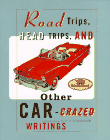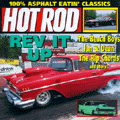|
|
|
|||
 |
||||
Nitro Powered Outlaw Culture” 
A lot of baggage is stored in our little corner of the entertainment rumpus room, “our” meaning drag racing. One does not exhaust the drag race dictionary or experience with the words “dragster,” “funny car,” “nitro,” “gasser,” and “stocker.” To belabor the point slightly, when you use terms like “hot rod,” “customs,” “candy color,” “rock n' roll,” “lowrider,” “pinstriping,” throw in “outlaw,” what auto racing discipline do you think of first? Drag racing (and salt flats cars). Not NASCAR. Not Indy Car. Not sprints or midgets. None of them. It’s straightline stuff. What Leah Kerr does exceptionally well is show how all of these items wind up in a mixmaster she has labeled “nitro powered outlaw culture.” Keep in mind, she is writing cultural history overall, where drag racing history is the key component but not the end all, be all of the book. “Driving Me Wild” is a fast-moving account of how speed, style, and art came together to form this country’s most unique automotive culture. The Intro and Chapter 1 are key chapters and show a strong writing talent, a good hard fix on the subject, and successfully launches Kerr’s probe into this subject. Using her initial experiences (physical reactions to an eye-watering, ear-pounding blown nitro car) as starting blocks, her narrative runs the gamut in this section from what pulls in the participants and fans, and the snake charm hypnosis of speed. It is in this segment that she produces some of the best copy I’ve read on why people get involved with this nuttiness. Her descriptions of people watching the fuel cars fire in the pits, the literal addiction to the sound and the fury of the deal, the way it sculpts individuals and families, and the genius, invention, and beauty that is spun out of this tornado, all are presented picture clear. Historically, she does a bang-up job on tracing the roots of this crowd. World War II, the wide-open spaces of Southern California, and (by implication to me) a country swollen in the pocket from riches from winning the war - there were a lot of people, lower working class to the wealthy that had the time and money to do things they wanted, which is where Kerr’s book gets its foot in the door. To wit, she writes of the young men of the immediate post-WWII era caught up in jalopies and hot rods, “That freedom of expression must’ve been dizzying, to be able to travel where you wanted, in the car you wanted, at the speed you wanted… For the first time, in U.S. history, teenagers were free to invent their own identities.” Inventing their own identities and creating a world-changing culture based on life and magic with machinery are what Kerr devotes the next seven chapters. Nods to some of the heroes (and these heroes are the colorful, groundbreaking, and courageous she feels are most connected to her theme) Joaquin Arnett and the “Bean Bandits,” Stone-Woods-Cook, Shirley Muldowney, Della Woods, Paula Murphy, Malcolm Durham, “Jet Car Bob” Smith, “Jungle Jim” Liberman, “Jungle Pam,” John Force, “Wild Willie” Borsch, and Linda Vaughn are handled in the first three chapters. The last five chapters deal specifically with the culture of speed and I found this area the most interesting. What roots do people like graphic artists Von Dutch, “Big Daddy” Roth, Robert Williams, Stanley Mouse, phenoms like lowriders, George Barris and the custom people, and rockers, punkers, and movie makers have that deposited them with drag racers in this swirling bouillabaise? That long-winded question is handled in this part of the book and aided and abetted by a ton of great graphics, artist samples, a list of great hot rod movies and records, and superior photography. I think that like a number of you, I never really gave drag racing culture that much attention. I just knew it was there and it had its heroes. Leah Kerr throws an attention-grabbing and very educational spotlight on it. There are a few minor historical errors in the drag race segment, but they do nothing to detract from a book that any car buff should own. My advice to the reader? Buy it.
|
||||
|
Copyright 1999-2001, Drag Racing Online and Racing Net Source |
||||





